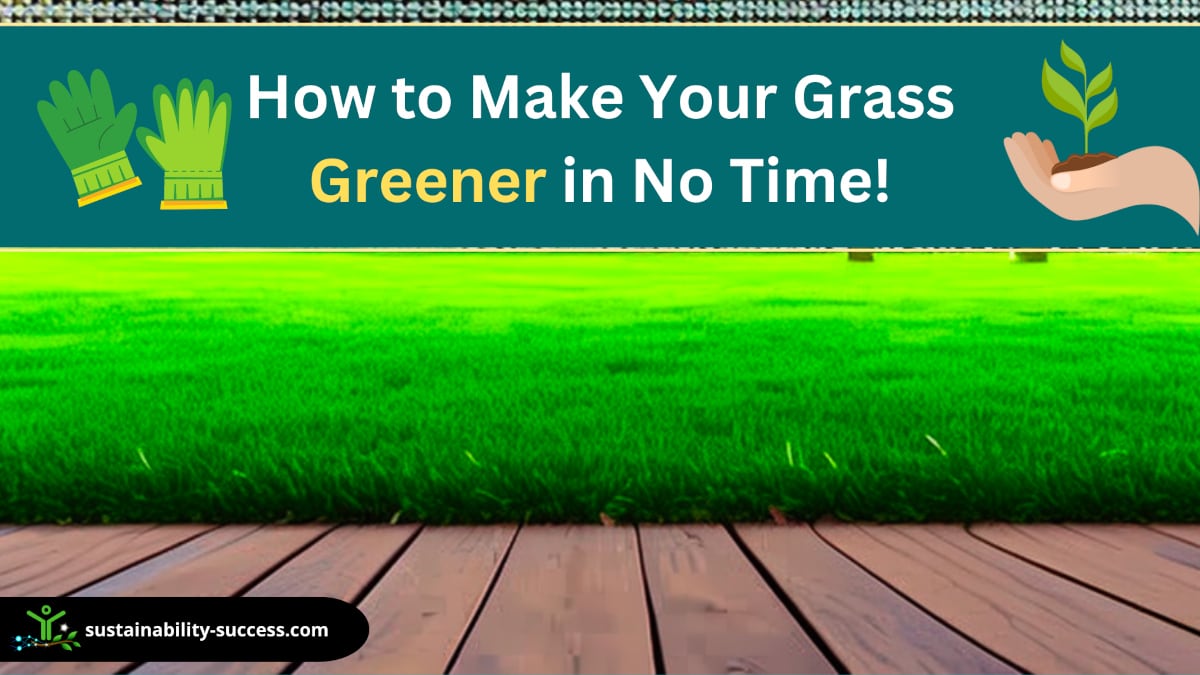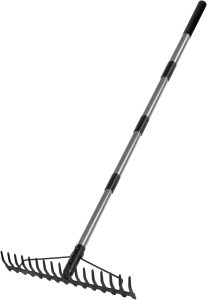Being passionate about nature and the environment, I understand that having a green lawn can be very important. That’s why I’m here to give the best tips about how to make your grass greener in no time (or how to get green grass if you are a beginner). You’ll have an enviable lawn that will be the envy of your neighbors! Now, you may be asking yourself: how to make my lawn greener?
To make your grass greener, there are a few key steps you can take:
- Fertilize your lawn regularly (once every 6-8 weeks).
- Mow high and often to keep the grass healthy.
- Water deeply but infrequently (1-2 times per week).
- Aerate your lawn to improve soil quality.
- Remove weeds and pests promptly.
However, this is not all, here’s everything you need to know on how to get green grass!
How to get green grass: What You Need to Know
The best way to make your grass greener DIY and without using toxic chemicals is by following the steps below.
Note that in case you have hard dirt, if you need to plant your lawn, then check when is best to plant grass seeds and how to plant grass seed on hard dirt.
1. Mow High and Often: Tips for Mowing a Healthy Lawn

Mowing high ( 3 inches or more, best from 3.5 to 4 inches ) helps keep weeds away by preventing sunlight from reaching them while encouraging deeper root growth for healthier turfgrass plants. It’s important not to cut more than one-third off at any given time either.
Cutting too low stresses out grasses making them susceptible to disease and pests!
Be sure to sharpen blades regularly too since dull blades rip rather than cut resulting in shredded ends that brown quickly due to dehydration.
Here’s the best push mower for a perfect lawn:
OUR BEST PICK
EGO Power+ LM2101 Push Mower
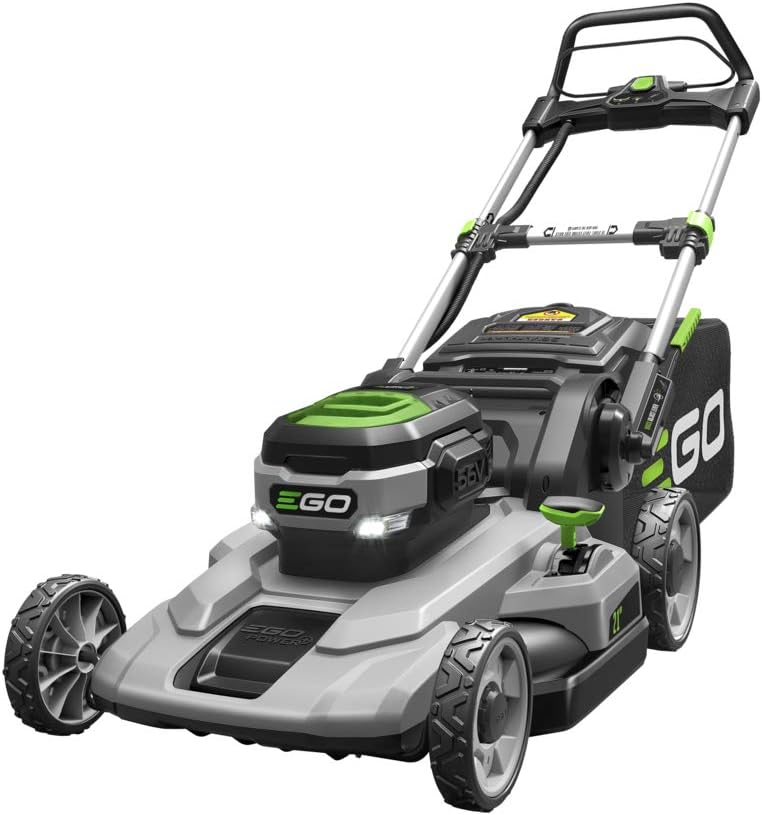
★★★★★ 4.6
Say goodbye to noisy, smelly, and fume-filled mowing with the EGO Power+ LM2101 push mower. Equipped with a powerful 56V Lithium-ion battery, this mower delivers gas-like performance without the mess. With up to 45 minutes of run time, 6 cutting positions, and a lightweight design, you’ll effortlessly tackle even the toughest grass types. Plus, the eco-friendly design means you’re doing your part for the planet too. It’s time to experience what it truly means to “cut the cord”.
Pros:
- Environmentally friendly
- Quiet
- Lightweight design
- Good warranty
Cons:
- Not self-propelled
And here’s the best edger & trimmer:
OUR PICK: Edger & Trimmer
Worx WG163 GT 3.0 – Edger & Trimmer
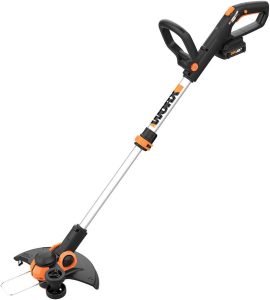
★★★★★ 4.5
Looking for a trimmer and edger that won’t break the bank or your back? Check out the Worx WG163 GT 3.0 Edger & Trimmer. This versatile tool converts from a trimmer to a wheeled edger in just seconds, with no additional tools required. The innovative Command Feed system gives you instant line feeding at the touch of a button. With adjustable handle positions, a head that tilts 90° for easy trimming in awkward spaces, and a spacer guard to protect your landscaping, the Worx WG163 GT 3.0 is a must-have for any homeowner.
Pros:
- Lightweight
- Two batteries
- Electric
- Adjustable body
- Easy to use
Cons:
- Not for heavy-duty
2. Proper Lawn Irrigation Techniques

Proper watering techniques are essential for maintaining healthy grass growth. The key is to water deeply but infrequently so that the water penetrates deep into the soil instead of just wetting the surface. This encourages deeper root growth which makes your grass more drought-resistant in the long run.
- Water early in the morning – Early morning is generally considered to be the best time to water because there will be less evaporation from heat during this period.
- Don’t overwater – Overwatering is just as bad as underwatering because too much water can cause root rot and other diseases in your lawn.
- Check for runoff – If you notice any runoff after watering, stop immediately and adjust your irrigation system accordingly.
3. Benefits of Aeration and Dethatching
Aerating the soil is essential for keeping your lawn healthy, as it helps reduce compaction and improves drainage. Additionally, aeration can help break up thatch (the layer of dead grass clippings and other organic material on top of the soil) which can prevent water, air, and nutrients from reaching your grass roots.
Dethatching is another way to get rid of thatch buildup, but should only be done if necessary as it can damage or even kill your turf grass. You can read about the pros and cons of dethatching a lawn here.
When aerating or dethatching your lawn, make sure you use a specialized tool designed for this purpose. If you don’t have access to one of these tools, consider hiring a professional landscaper who has experience with these techniques.
Areating and detaching are 2 of the most important things you can do to make your grass greener. To do a proper job you will need the right machine, I hand-picked the best one for you here:
4. The Benefits of Fertilizing Your Lawn
Fertilizing your lawn provides essential nutrients such as nitrogen, phosphorus, potassium, and iron which help promote growth and health in turfgrass plants.
- Nitrogen helps keep leaves green while phosphorus aids in root development.
- Potassium is beneficial for cell walls.
- Iron helps build chlorophyll which gives leaves their green color.
It’s important to fertilize at least once per year using a fertilizer specifically formulated for lawns (not gardens). Test your soil first so you know what minerals are lacking before applying any fertilizer.
When applying fertilizer, spread it evenly over the entire area using either a broadcast spreader or drop spreader.
Make sure not to apply too much, otherwise, you could burn or kill off patches of grass. Also avoid fertilizing when temperatures exceed 85 degrees Fahrenheit since high temperatures increase the risk of burning your grass.
Picking the right fertilizer for your lawn can be quite tricky, so here’s a great fertilizer that I can recommend to get greener grass:
Scotts Turf Builder Lawn Food

★★★★★ 4.5
Achieving a lush, green lawn can be hassle-free with Scotts Turf Builder Lawn Food. Rich in nutrients, this all-in-one lawn fertilizer will improve your grass’s ability to absorb water and nutrients, building deep roots that make your garden more resilient. Perfect for any grass type, this fertilizer uses Scotts All-In-One Particles technology, which ensures even feeding and greening. What’s even better? It’s a year-round solution, saving you from the need to build complicated lawn care routines. Why wait? Give your lawn the nutrients it needs with Scotts Turf Builder Lawn Food.
5. How Compost Can Improve Soil Quality
Compost adds organic matter back into depleted soils, helping improve fertility, texture, structure, moisture retention capacity, and nutrient availability.
Adding compost also helps reduce compaction by loosening hard soils so they’re easier to work with. When adding compost, mix it thoroughly with existing soil before planting anything new.
Use aged compost rather than fresh compost; aged compost contains fewer weed seeds than fresh compost does.
Compost also serves as an effective natural mulch when spread over the bare ground between rows or around individual plants. Not only does mulching protect against weeds by blocking light from reaching them, but it also helps retain moisture in hot weather conditions.
For best results, use two inches or more of mulch around plants (enough that light cannot penetrate through it) then replenish every few months depending on wear and tear from wind or rain.
6. Identifying and Removing Weeds From Your Lawn
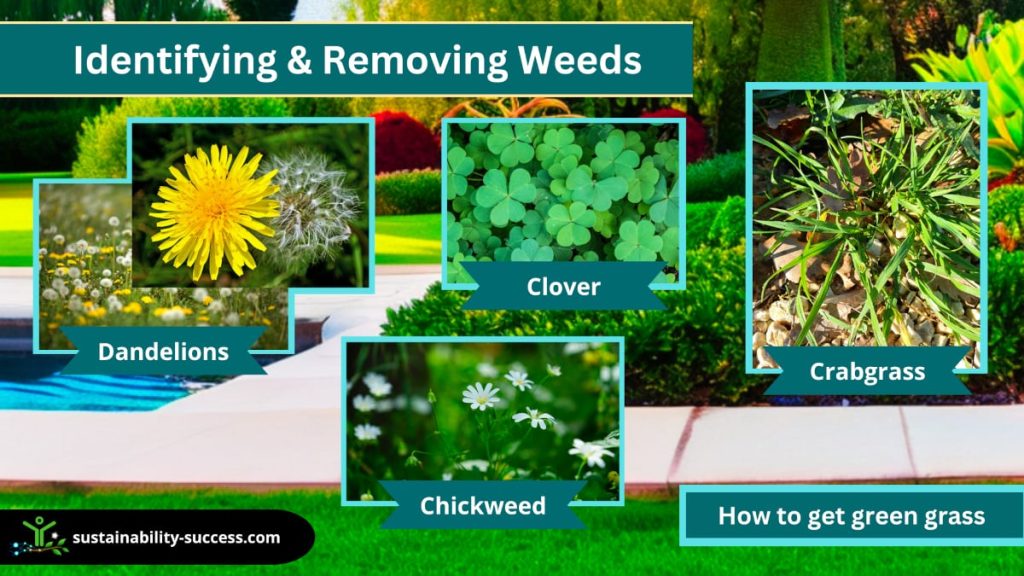
Weeds can be a nuisance for any lawn, but they don’t have to take over your yard. The first step in getting rid of weeds is to identify them correctly.
Common lawn weeds include dandelions, clover, crabgrass, and chickweed. Once you’ve identified the weed, it’s time to remove it. Hand-pulling is an effective way of removing small patches of weeds from your lawn. For larger areas, you may need to use natural weed killers such as vinegar or boiling water (I would avoid using herbicides if possible).
By the way, did you know that it is possible to have a nice micro clover lawn? I wrote this article about the micro clover lawn pros and cons, check it out!
7. Pest Control: Managing Insects and Other Pests in Your Yard
Insects and other pests like rabbits can wreak havoc on your lawn if left unchecked. Yes, rabbits eat grass and can cause significant damage to your lawn, causing yellow patches on your grass, check it out.
To protect your grass from these pesky critters, start by regularly inspecting for signs of infestation such as holes in the grass or wilted leaves. If you spot any insects or pests on your property, take measures to eliminate them immediately using appropriate pest control methods.
You should also practice preventive pest control by keeping your grass healthy with proper fertilization and irrigation techniques so it has fewer opportunities for pests to thrive.
Check & Get rid of Grubs
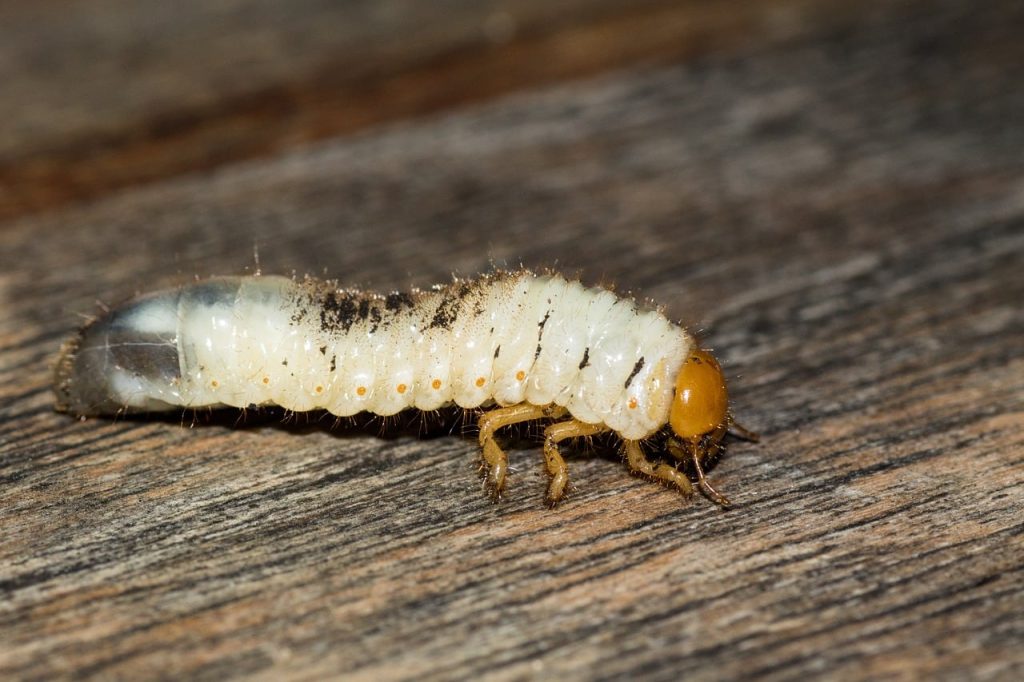
Make sure to check for the presence of grubs on your lawn (they look like in the above picture). Those larvae feed on roots and can greatly damage your grass.
If you believe to have a problem with grubs, then you should follow these steps:
Look for the presence of Grubs
Look for brown patches that don’t disappear. You might have to dig deep and count the number of these larvae you spot.
Beneficial Nematodes
Next up, get yourself some Beneficial Nematodes. These microscopic worm-like creatures are nature’s hit squad – and they feed off those grubs! Follow the instructions on the packet, and let the nematodes do the heavy lifting for you. I selected the best ones for you below!
Soil Solarization
Another option is Soil Solarization. This involves covering the lawn with a plastic sheet (after properly watering it) for a few weeks. It’s like baking your lawn, and it’s a perfect fool-proof way that lets that hot sun do the job of destroying the grubs and eggs without needing any nasty chemicals. However, keep in mind that if not done correctly, this process may damage your grass.
Use Chemicals
But if you’re more of a chemical kind of person, you can use insecticides like carbaryl, imidacloprid, and chlorantraniliprole. BUT be careful. Not only can these guys mess with helpful insects, but they also have a dark side in damaging our environment. Keep the use of these chemical weapons to a minimum.
Finally, you can also attract squirrels and birds on your lawn, they will eat some grubs and reduce the damage they can do to your lawn. But it is still advised to take proper care of those insects.
8. What Equipment You Need To Care For Your Lawn
Having the right tools can make caring for your lawn much easier. Investing in quality equipment such as:
- Push mower
- Edger & Trimmer
- Rake
- Shovel
- Wheelbarrow
- Hose nozzle
- Sprinklers
- Fertilizer spreader
- Aerator
- Dethatcher
- Leaf blower / vacuum
In addition, you also need a storage shed to keep all of the necessary tools and equipment. Here are some great storage options available:
Storage Shed
Here are some of my suggested items:
BUDGET PUSH MOWER
Great States 815-18 Push Mower

★★★★★ 4.4
Get ready for a lawn that will make your neighbors envious! Great States 815-18 push mower is a cost-effective and planet-friendly option to maintain a green, healthy lawn. Say goodbye to the noisy power mowers and hello to precise cutting action with this lightweight and durable alloy steel manual lawn mower. Give your lawn the love it deserves, and get ready for compliments!
Spreader & Leaf Blower
General Gardening Tools
Those tools will ensure that you have everything necessary for proper maintenance.
9. Go Organic: Benefits Of An Organic Lawn Care
Organic lawn care means avoiding synthetic fertilizers and pesticides while still providing essential nutrients needed by turfgrass plants. This relies heavily on composting techniques which help improve soil structure while reducing runoff pollution into nearby waterways.
Additionally, organic treatments are often less expensive than traditional chemical-based products making them more budget-friendly.
By choosing an organic approach when caring for your lawn not only do you get healthier results but also help reduce the environmental damage caused by chemical runoff. This is a more sustainable way to keep your lawn green!
10. DIY Or Professional? Pros And Cons Of Hiring A Lawn Care Service
Keeping up with regular maintenance tasks such as mowing trimming edging weeding aerating fertilizing dethatching controlling pests etc.. can go long way towards ensuring lush beautiful healthy looking turf throughout the year!
Regardless of your choice about hiring a professional or DIY, make sure to follow at least those essential simple tips to help maintain your oxygen producing grass in pristine condition no matter the season:
- Water deeply but infrequently – Deeply saturating soil every 7 – 10 days encourages deep root growth & discourages shallow roots which require frequent watering & prone to drought stress & disease problems.
- Mow high – Maintaining higher cutting height reduces stress on grass plants and allows roots to grow deeper and stronger helping retain moisture better during hot dry periods plus keeps weeds away!
11. Tips for Keeping Your Lawn Looking Its Best
Keeping your lawn looking its best requires regular maintenance. Here are some tips to help you get started:
- Test your soil annually to ensure it contains the right minerals.
- Sharpen the blades of your mower regularly for a cleaner cut.
- Aerate compacted soils every so often to improve water absorption and nutrient availability.
- Mow at the right height for your grass type and don’t over-cut it.
- Fertilize with nitrogen in late summer to promote thicker, greener grass in early spring.
- Water properly using techniques suggested by this Purdue University research.
12. Enjoy the Greenery: Taking Care of Your New Green Space
Once you’ve got a handle on all the basics of lawn care, like mowing at the right height and watering properly, it’s time to enjoy all that greenery! Take some time each week (or even just once a month) to appreciate how great your new green space looks after all that hard work.
If there are any special features like trees or flower beds that you want to be included in your landscape design plan, now is the time! Add those elements as well as anything else that will make this outdoor area truly yours.
By the way, you may also be wondering: why is grass green? In this case, I have you covered with a dedicated article on this topic!
Professional Lawn Without Hefty Price Tag!
Sunday Lawn Care DIY

★★★★★
Get your dream lawn without the headache (and the hefty price tag) with the Sunday Lawn Care Custom Plan. It’s like having a personal lawn specialist in your pocket, giving you all the tools and support you need to transform your lackluster lawn into a vibrant, envy-inducing green oasis. Say goodbye to the stress and hello to a greener, more enjoyable outdoor space!
Pros:
- Greener grass
- Affordable
- Tailored plan
- Expert support
- Eco-friendly ingredients
- Convenient seasonal deliveries
- Easy application
Cons:
- Ongoing cost
- Requires a bit of patience
Conclusion
Making your grass greener doesn’t have to be a daunting task. By following the simple steps outlined in this article, you can create a lush and vibrant lawn that will make your neighbors jealous.
With regular mowing, watering, fertilizing, aerating, and weed control, you can enjoy a beautiful green lawn all year round.
So don’t wait any longer, start taking action today to get the green lawn you’ve always wanted! With these tips on how to make your grass greener, you’ll be well on your way to having a lush and vibrant yard in no time!
FAQ
What can I do to make my grass greener?
To make your grass green and healthy, you should use a lawn fertilizer that contains nitrogen, phosphorous, and potassium. Nitrogen is essential for lush green growth, while the other two nutrients help support strong roots. Fertilizing your lawn regularly will ensure it stays vibrant and healthy.
How can I make the grass thick and green?
To make your grass thick and green, use a lawn fertilizer with high nitrogen content. This will help the grass to grow strong from the roots and stay healthy and lush. Additionally, fertilizers containing phosphorous and potassium can provide additional nutrients to support the grass.
What steps can I take to get a healthy, green lawn?
To make your grass lush and green, apply a lawn fertilizer with nitrogen, phosphorous, and potassium. These nutrients will help strengthen the roots of the grass and promote healthy growth. Nitrogen is especially important for achieving a vibrant green color.
What home remedy can be used to make grass greener?
To achieve a lush, green lawn without the use of chemicals, try some natural remedies! Soaking grass in a solution of Epsom salt and water is one popular home remedy to promote seed germination and healthier growth of your grass. This helps to provide essential nutrients like magnesium and sulfur that promote healthy growth. Additionally, adding coffee grounds to your soil can help to keep it green by providing nitrogen.

